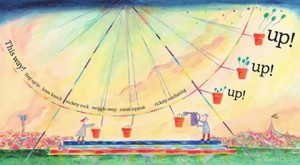June 7, 2012
Picture books are the most wild, innovative, untethered, experimental literary genre I know
From an excellent post by Laurel Snyder on the dangers of turning on to chapter books too soon:
“Picture books are the most wild, innovative, untethered, experimental literary genre I know.
The marriage of images and text is partly to blame for this, I think. Something about the collaborative process too, perhaps—an artist and a writer challenging each other, with a common purpose but different modes. But I want to believe that the main reason picture books can be so different is that kids are so different.
At the tender age when kids first encounter picture books they are open, accepting, free-thinking. A two year old doesn’t really expect anything when she picks up a book, and so a book for a two year old can be anything. Physical comedy. Visual art. A puzzle. Books for kids can pop-up or scratch-and-sniff. They can be meta-fiction. They can speak multiple languages or intertwine multiple distinct storylines. There are almost no rules to picture books. Kids scribble in them, build forts with them. Picture books are experiential on every level you can imagine, and some you can’t.
They’re awesome.”
May 31, 2012
Franklin Stamps
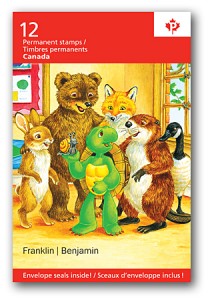 There is not much we love at our house more than we love mail and books (except perhaps for bunting, tea, and train journeys) and it’s always a joy when worlds collide. Yesterday, we picked up a set of Franklin the Turtle stamps at the post office, and we’re in love with them. But they confuse us too, because Harriet thinks they’re stickers and wants to stick them all over her hands and legs, and as for me, I can’t see myself using them anytime soon because then we wouldn’t have them anymore!
There is not much we love at our house more than we love mail and books (except perhaps for bunting, tea, and train journeys) and it’s always a joy when worlds collide. Yesterday, we picked up a set of Franklin the Turtle stamps at the post office, and we’re in love with them. But they confuse us too, because Harriet thinks they’re stickers and wants to stick them all over her hands and legs, and as for me, I can’t see myself using them anytime soon because then we wouldn’t have them anymore!
More about postal goodness: the joy of postcards.
May 25, 2012
New book by Sheree Fitch: Night Sky Wheel Ride
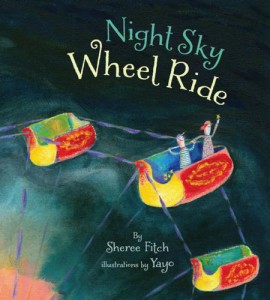 A new book by Sheree Fitch is a very important event in our house, and so we were overjoyed to get our copy of Night Sky Wheel Ride yesterday. It’s the story of a Ferris wheel ride against a night sky and the dark sea, a brother and sister ecstatic at finally being big enough to ride. “Are we big enough this year, Mama?/ Are we brave enough, Brother?/ Sister, are you ready to fly?” Fitch’s free verse is delicious to recite, full of twists and turns that melt “sticky quick on the tips of our tongues.” Rhymes and repetition replicate the Ferris wheel’s momentum, and apart from the people down below who are “dancing jelly beans”, the poem’s imagery stays pretty literal because when you’re dealing with a Ferris wheel, metaphors aren’t entirely necessary. The illustrations, however, tell an altogether different story, Yayo taking cues from the language and pushing the story even further with a furious whimsy, turning everything into absolutely nothing like it seems. His Ferris wheel is an apple tree, a rowboat, a washing machine’s spin cycle, a bird perch.”Can you hear the mermaids murmur/beluga whales sing/ feel the whirling stir/ of every little humming phosphorescent thing?”
A new book by Sheree Fitch is a very important event in our house, and so we were overjoyed to get our copy of Night Sky Wheel Ride yesterday. It’s the story of a Ferris wheel ride against a night sky and the dark sea, a brother and sister ecstatic at finally being big enough to ride. “Are we big enough this year, Mama?/ Are we brave enough, Brother?/ Sister, are you ready to fly?” Fitch’s free verse is delicious to recite, full of twists and turns that melt “sticky quick on the tips of our tongues.” Rhymes and repetition replicate the Ferris wheel’s momentum, and apart from the people down below who are “dancing jelly beans”, the poem’s imagery stays pretty literal because when you’re dealing with a Ferris wheel, metaphors aren’t entirely necessary. The illustrations, however, tell an altogether different story, Yayo taking cues from the language and pushing the story even further with a furious whimsy, turning everything into absolutely nothing like it seems. His Ferris wheel is an apple tree, a rowboat, a washing machine’s spin cycle, a bird perch.”Can you hear the mermaids murmur/beluga whales sing/ feel the whirling stir/ of every little humming phosphorescent thing?”
The story takes on a special poignancy when you learn the story behind it.
May 21, 2012
Show Me a Story: Why Picture Books Matter
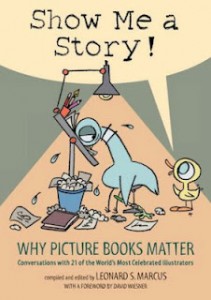 Last Sunday, I had a the rare pleasure of walking into a bookshop, browsing awhile, and buying a book I had only just discovered. That book was Leonard Marcus’s Show Me a Story: Why Picture Books Matter, 21 Conversations with 21 of the World’s Most Celebrated Illustrators, which I bought not just for its cover art (a Mo Willems book for me!), but because the illustrators interviewed included Quentin Blake, John Burningham, Eric Carle, James Marshall, Robert McCloskey, Lois Ehlert, Helen Oxenbury, Maurice Sendak, Peter Sis, Rosemary Well, William Steig, and Willems himself, among others. The book was wonderful. I was amazed to learn that Oxenbury and Burningham are married, that Tana Hoban and Russell were siblings, Steig was incredibly grumpy, Blake said he could only draw automobiles that were falling apart, that George and Martha were inspired by Frog and Toad (but of course!). That Sendak was a mentor to so many others, and that picture book illustration was such an old boys’ network. I loved learning about how many illustrators had a background in graphic design, reading their ideas about fonts in picture books, how much of a role technology had– being able to do books in full colour changed everything. And now it’s a big deal when an illustrator wants to hold back a bit, do some pages in black and white. I also love that as I’m still a picture book novice, I can read a book like this and discover so many new authors and illustrators– the book is in alphabetical order, and first up was Mitsumasa Anno with whom I fell in love as soon as I hit the library.
Last Sunday, I had a the rare pleasure of walking into a bookshop, browsing awhile, and buying a book I had only just discovered. That book was Leonard Marcus’s Show Me a Story: Why Picture Books Matter, 21 Conversations with 21 of the World’s Most Celebrated Illustrators, which I bought not just for its cover art (a Mo Willems book for me!), but because the illustrators interviewed included Quentin Blake, John Burningham, Eric Carle, James Marshall, Robert McCloskey, Lois Ehlert, Helen Oxenbury, Maurice Sendak, Peter Sis, Rosemary Well, William Steig, and Willems himself, among others. The book was wonderful. I was amazed to learn that Oxenbury and Burningham are married, that Tana Hoban and Russell were siblings, Steig was incredibly grumpy, Blake said he could only draw automobiles that were falling apart, that George and Martha were inspired by Frog and Toad (but of course!). That Sendak was a mentor to so many others, and that picture book illustration was such an old boys’ network. I loved learning about how many illustrators had a background in graphic design, reading their ideas about fonts in picture books, how much of a role technology had– being able to do books in full colour changed everything. And now it’s a big deal when an illustrator wants to hold back a bit, do some pages in black and white. I also love that as I’m still a picture book novice, I can read a book like this and discover so many new authors and illustrators– the book is in alphabetical order, and first up was Mitsumasa Anno with whom I fell in love as soon as I hit the library.
“One of the most important things is to laugh with your children and to let them see you think they’re being funny when they’re trying to be. It gives children enormous pleasure to think they’ve made you laugh. They feel they’ve reached one of the nicest parts of you.” –Helen Oxenbury
May 17, 2012
Picture books in which animals are put in jail
This is something I’ve been thinking about for some time. It is by no means a comprehensive list.
 Curious George by Margret and HA Rey: Early Curious George was not only an avid cigar smoker, but ends up in jail for making prank calls to the fire department. Being a monkey, he is able to escape from jail with relative ease when a prison guard stands on one end of George’s cot whilst chasing him and lifts the other end up to the window. He floats away in a balloon. Later, he stars in a movie.
Curious George by Margret and HA Rey: Early Curious George was not only an avid cigar smoker, but ends up in jail for making prank calls to the fire department. Being a monkey, he is able to escape from jail with relative ease when a prison guard stands on one end of George’s cot whilst chasing him and lifts the other end up to the window. He floats away in a balloon. Later, he stars in a movie. 
Veronica by Roger Duvoisin: Veronica is a hippo who hates to blend into her herd (whose collective noun is actually “bloat”, but this isn’t part of the text). She gets around her camoflage by escaping to the city, but the gets hauled away for holding up traffic. The jail, unfortunately, barely contains her (speaking of bloat), and they have to bust down the doors to get her out of the place after a sympathetic little old lady comes to her aid and wins her freedom.
 Chouchou by Francoise: Chouchou is a little French donkey who leads a simple but pleasant life having tourists pose with her for photographs. One day while provoked, however, she bites a young customer and is thrown in jail. She is only freed once the local children attest to her gentleness, demonstrating to officials that she’s indeed a harmless creature. She is freed in time to officiate at her photographer-owner’s wedding.
Chouchou by Francoise: Chouchou is a little French donkey who leads a simple but pleasant life having tourists pose with her for photographs. One day while provoked, however, she bites a young customer and is thrown in jail. She is only freed once the local children attest to her gentleness, demonstrating to officials that she’s indeed a harmless creature. She is freed in time to officiate at her photographer-owner’s wedding.
May 14, 2012
Oh come over here, kid we’ve got all these books to read
“Oh come over here, kid we’ve got all these books to read,
With the turtles and frogs, cats and dogs who civilize the centuries,
And in a world that’s angry, cruel and furious,
There’s this monkey who’s just curious,
Floating high above a park with bright balloons.”
From “I am the one who will remember everything” by Dar Williams, from her very wonderful new album In the Time of the Gods which I received for Mother’s Day, along with a new guitar tuner.
May 8, 2012
On Maurice Sendak
 The other day I was talking about friends of ours and said, “They didn’t have a party when he turned one,” to which Harriet responded, “His immediately family frowned on fun.” Which isn’t technically true, but is a testament to how our favourite books reside so centrally in our consciousnesses, even after the books are closed,that she could so reference Maurice Sendak’s Bumble Ardy off the cuff.
The other day I was talking about friends of ours and said, “They didn’t have a party when he turned one,” to which Harriet responded, “His immediately family frowned on fun.” Which isn’t technically true, but is a testament to how our favourite books reside so centrally in our consciousnesses, even after the books are closed,that she could so reference Maurice Sendak’s Bumble Ardy off the cuff.
Maurice Sendak died today at the age of 82. I didn’t read a lot of him when I was little, apart from Where the Wild Things Are, but I didn’t even read that one enough to properly probe its depths. Truth be told, I still don’t properly get Maurice Sendak, which sometimes annoys me, and certainly makes me uncomfortable, but it’s also the reason why his work fascinates me so much. His stories are either everything or nothing, and depending upon what mood I’m in, my perspective changes all the time.
When I first read Outside Over There though, I started to get a sense of how much is going on in his work underneath the surface, even if the action itself is not altogether accessible to me. That book is so weird, and I’ve read it a million times, and I still don’t really understand it, but I suspect that the text is as detailed and full of allusions as the illustrations are. It’s a mystery that I’ll be unravelling forever. It’s much easier to out-and-out love The Night Kitchen, though in some ways that book is even weirder, but I love the almost rhymes and the box cityscape. I want to always have cake in the morning too. Cock a doodle doo. And then yes, Wild Things, the most graspable of the three and I love its run-on sentences, and I love the wild rumpus just like everyone. I also love the line, “Please don’t go. We’ll eat you up. We love you so.” Life is complicated. 
More straightforward is how much we love Maurice Sendak’s illustrations– Little Bear is so absolutely wonderful. I also really love Chicken Soup With Rice, which dares to boil a pot at the bottom of the sea. And his latest book, Bumble Ardy, which we bought last Fall and whose weirdness Harriet has never even raised an eyebrow at yet. Because she’s still little enough to take the world as she finds it, and how much richer is she (and all of us) for Maurice Sendak’s work being in it.
May 3, 2012
Our Best Book of the Library Haul: Katy the Caboose Who Got Loose by Bill Peet
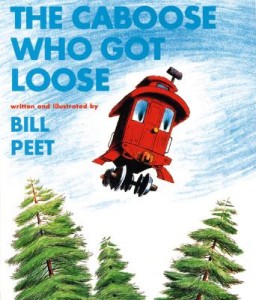 I’m sure I’m not the only person who has read this book at least twice daily all week long, but still, the experience has granted me a certain authority to say that it’s one of the finest train books out there– even better than Virginia Lee Burton’s Choo Choo and Don Freeman’s Chuggy. The Caboose Who Got Loose by Bill Peet is about a delightful red caboose called Katy who longs for quiet and stability, for the end of a life of rumbling, smoke, and dark tunnels. Her wish comes true in the most surprising way, but not until the very end of the story. Before it does, there is plenty of train track adventures, rumbling through field and town, passing houses with faces as charming as Katy’s own, and perilous pulls around mountain ledges. Our resident train fiend loved this one, and I did too, mostly because I’m a sucker for rhyming couplets every time. If there is a book I have to read twice daily for a week, it always goes down so much better in verse.
I’m sure I’m not the only person who has read this book at least twice daily all week long, but still, the experience has granted me a certain authority to say that it’s one of the finest train books out there– even better than Virginia Lee Burton’s Choo Choo and Don Freeman’s Chuggy. The Caboose Who Got Loose by Bill Peet is about a delightful red caboose called Katy who longs for quiet and stability, for the end of a life of rumbling, smoke, and dark tunnels. Her wish comes true in the most surprising way, but not until the very end of the story. Before it does, there is plenty of train track adventures, rumbling through field and town, passing houses with faces as charming as Katy’s own, and perilous pulls around mountain ledges. Our resident train fiend loved this one, and I did too, mostly because I’m a sucker for rhyming couplets every time. If there is a book I have to read twice daily for a week, it always goes down so much better in verse.
April 29, 2012
Morstad, Nadeau and Arsenault: 3 Great Illustrators
I realize that I’m not telling you anything you don’t know already, because it’s not that these illustrators are up-and-coming, but that they’re everywhere. Behind the books we love and books we’re still discovering, and perhaps it’s incidental that all the books they illustrate are brilliant, but I suspect it isn’t. In fact, I think that at least half of the brilliance these illustrators can totally take credit for.
 Julie Morstad: I first bought a child one of Julie Morstad’s Henry books (written by Sara O’Leary) back in 2008, and have been doing so regularly ever since, as recently as last weekend. (It was When I Was Small. Went over a charm). She’s also the pictorial force behind the award-winning Singing Away the Dark by Caroline Woodward, which I adore, and also the art book Milk Teeth by Drawn & Quarterly, which I’m currently winding my little head around. And now I hear she’s got a new book, an illustrated version of Robert Louis Stevenson’s poem The Swing and I am so very excited.
Julie Morstad: I first bought a child one of Julie Morstad’s Henry books (written by Sara O’Leary) back in 2008, and have been doing so regularly ever since, as recently as last weekend. (It was When I Was Small. Went over a charm). She’s also the pictorial force behind the award-winning Singing Away the Dark by Caroline Woodward, which I adore, and also the art book Milk Teeth by Drawn & Quarterly, which I’m currently winding my little head around. And now I hear she’s got a new book, an illustrated version of Robert Louis Stevenson’s poem The Swing and I am so very excited. 
Janice Nadeau: Nadeau is the illustrator of Cinnamon Baby, which is one of our family’s favourite books ever (and I gave a copy of this book to somebody as recently as yesterday). Like Morstad and Arsenault, her illustrations have a vintage feel, an irresistible prettiness, but are also a bit cheeky and whimsical. She is also the illustrator of the award-winning graphic novel Harvey, and she’s the creator of the poster for 2012 TD Children’s Book Week (which is currently hanging on Harriet’s bedroom door).
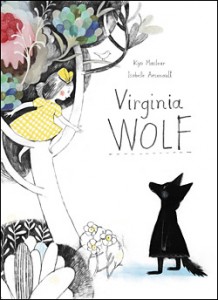 Isabelle Arsenault: We discovered Isabelle Arsenault via Kyo Maclear’s wonderful first picture book Spork: never has cutlery appeared so full of vitality (and so shiny!). Harriet was still little but found the illustrations, of the baby in particular, very appealing. And then along came Arsenault next with Maxine Trottier’s award-winning Migrant, the beautiful story of a little girl from Mexico whose family comes north to Canada to work as farmers every summer. Her latest is Virginia Wolf, also with Maclear, and I’ve already written about how much I adore it. Though I haven’t bought a copy yet for any library except our own, but I suspect it’s going to make a good gift one of these days soon.
Isabelle Arsenault: We discovered Isabelle Arsenault via Kyo Maclear’s wonderful first picture book Spork: never has cutlery appeared so full of vitality (and so shiny!). Harriet was still little but found the illustrations, of the baby in particular, very appealing. And then along came Arsenault next with Maxine Trottier’s award-winning Migrant, the beautiful story of a little girl from Mexico whose family comes north to Canada to work as farmers every summer. Her latest is Virginia Wolf, also with Maclear, and I’ve already written about how much I adore it. Though I haven’t bought a copy yet for any library except our own, but I suspect it’s going to make a good gift one of these days soon.
April 3, 2012
Our Best Book of the Library Haul: Zoom by Tim Wynne-Jones & Eric Beddows
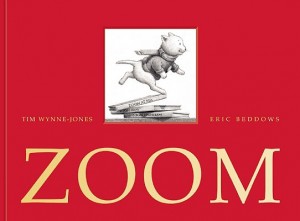 The great news is that the library workers have been back to work since Friday, and that we’re off to the library tomorrow to freshen this haul that’s been kicking around for a while. But this haul has been a good one, and it’s sustained us while the library workers had to go and stand up for what’s owed to them. And we have been particularly enamoured of the Zoom trilogy by Tim Wynne-Jones and Eric Beddows (who is also illustrator of Night Cars. It’s possible that I’m genetically predisposed to fall in love with any book his nib has touched).
The great news is that the library workers have been back to work since Friday, and that we’re off to the library tomorrow to freshen this haul that’s been kicking around for a while. But this haul has been a good one, and it’s sustained us while the library workers had to go and stand up for what’s owed to them. And we have been particularly enamoured of the Zoom trilogy by Tim Wynne-Jones and Eric Beddows (who is also illustrator of Night Cars. It’s possible that I’m genetically predisposed to fall in love with any book his nib has touched).
Zoom is all the elements of the fantastic, but without the dragon and gauntlet cliches. That Zoom is a small white cat is incidental to these stories, in which other worlds are accessed via strange tall stairways and bookcases in a rather curious house. Zoom’s adventures all involve his sea-faring Uncle Roy and a woman called Maria who explains nothing, and it never occurs to Zoom to ask anyway as he travels down an underground Nile to ancient Egypt, or follows a tiny corridor in pursuit of the North Pole.
